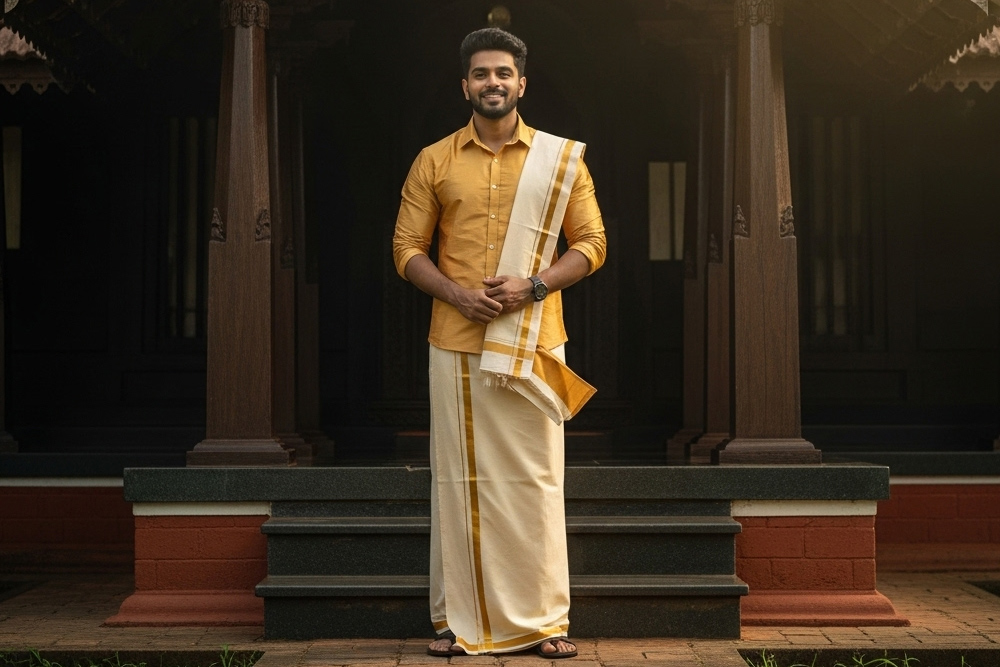The fashion world is ruled by suits, jeans, and joggers; the dhoti stands as a regular reminder of elegance, tradition, and cultural pride. Once seen as daily wear in India, the dhoti is now a popular choice for special occasions where heritage meets style. But many men still hesitate to wear one, unsure of when it’s appropriate or how to style it right.
If you’re a wearer or a first-timer, this article will help you explore the occasions that call for a dhoti and offer some smart styling tips to help you look your best.
1. Weddings and Engagements
How It Works:
A dhoti brings royal charm to wedding events, especially in South Indian and Bengali traditions, where it’s often the go-to attire for grooms and guests.
Styling Tip:
- Pair a silk dhoti with a matching or contrasting kurta or sherwani.
- Add a dupatta or angavastram for a royal touch.
- Choose traditional colours like cream, gold, or white with elegant borders.
2. Religious Ceremonies and Pujas
How It Works:
The dhoti is considered sacred and appropriate for spiritual occasions. It reflects simplicity, purity, and devotion.
Styling Tip:
- Opt for a plain cotton or khadi dhoti, often in white or off-white.
- Pair it with a simple kurta or go bare-chested with a shawl, depending on the custom.
- Keep it minimal, no flashy colours or accessories.
3. Festivals and Cultural Celebrations
How It Works:
From Pongal to Onam, Ganesh Chaturthi to Durga Puja, festivals are the perfect time to celebrate tradition through clothing.
Styling Tip:
- Go for dhotis with colourful borders or subtle prints.
- Match it with a vibrant kurta or regional wear (like angavastram or veshti).
- Add mojris, a wristwatch, or traditional headgear for flair.
4. Traditional Family Functions
How It Works:
Housewarming ceremonies, naming ceremonies, or ancestral rituals often involve traditional dress codes where the dhoti is preferred.
Styling Tip:
- Choose a light, breathable cotton dhoti if it’s a daytime event.
- Pair with a pastel kurta and minimalist accessories.
- Stick to a neat fold and avoid overly decorative styles.
5. Classical Dance or Music Performances
Why It Works:
Artists and performers often wear dhotis as part of their stage attire, especially in classical music or Bharatanatyam/Kathak events.
Styling Tip:
- Consider brightly coloured dhotis that complement the performance style.
- Secure the dhoti well for free of movement.
- Pair with traditional jewellery or accessories if the role demands.
6. Cultural or Heritage-Themed Events
How It Works:
From school days to office ethnic day celebrations, dhotis make a strong statement of cultural pride and individuality.
Styling Tip:
- Experiment with dhoti pants or pre-stitched dhotis for a modern twist.
- Combine with Nehru jackets or Indo-Western kurtas.
- Add sneakers or loafers for a fusion look.
7. Temple Visits
How It Works:
In many South Indian temples, wearing a dhoti is mandatory or at least preferred as a mark of respect and tradition.
Styling Tip:
- Use a white or cream cotton dhoti, often tied without a shirt.
- Make sure it’s neatly pleated and tied securely.
- Carry a simple towel over your shoulder.
Styling Tips to Wear a Dhoti Confidently
- Choose the Right Fabric: Cotton for comfort, silk for celebrations.
- Perfect the Tie: Practice tying it properly, or try pre-stitched versions if you’re new.
- Mind the Footwear: Mojaris, kolhapuris, or simple sandals complete the look.
- Fit Matters: A well-folded dhoti should fall neatly without bunching up.
- Keep It Neat: Iron it well and avoid overly crushed fabric.
The dhoti is not just a garment; it’s a cultural statement. If you’re attending a wedding, leading a puja, or celebrating a festival, wearing a dhoti connects you to heritage in a graceful, elegant way. With a few styling tricks and a bit of confidence, you can carry it just as proudly as any modern outfit.
So the next time an occasion calls for tradition, don’t hesitate. Tie that dhoti and wear your roots with style.

